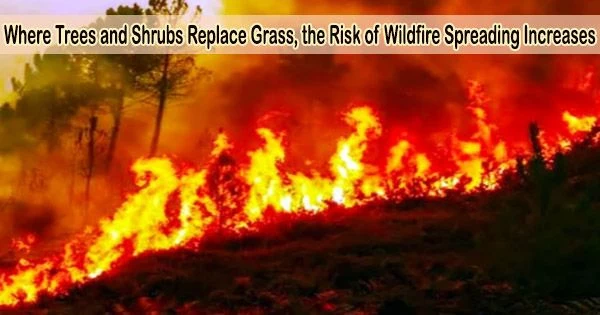Approximately the previous ten years, approximately 61,000 wildfires have burned an average of 7.2 million acres year across the United States. Once a wildfire starts spreading, issues like spot fires, where winds carry lofted sparks and start new fires outside of the original fire perimeter, exacerbate the firefighting task. The larger the possible spot fire distance, the harder it is to monitor, manage and put out wildfires.
Spot fires can start farther from the main fire perimeter as woody species like shrubs and trees take the place of herbaceous plants like grasses, according to a recent study led by University of Florida forest management expert Victoria Donovan.
This “woody encroachment” affects wetland and savanna ecosystems like longleaf pine, a significant habitat in Florida, in addition to grasslands, where the study is conducted.
“Spot fires are one of the most common reasons why houses burn in a wildfire,” said Donovan, an assistant professor with the School of Forest, Fisheries, and Geomatics Sciences at the UF/IFAS West Florida Research and Education Center in Milton, Florida.
“It’s not typically because the flames from wildfire reach a house, but that embers from that fire land on roofs, travel through home ventilation systems, or land on other combustible material on or near the home, and ignite the house from there. They’re a big concern for structural damage.”
According to Donavan’s study, controlled fire, which is frequently employed in Florida to restrict the growth of woody plants, may help lessen spot fires.
Our study shows that the risk of spot fire is much lower when you’re burning under the weather conditions used for prescribed fire, regardless of encroachment phase, compared to waiting for the potentially more extreme conditions we can see during wildfires. This tells us that using prescribed fire early to control encroachment and reduce fuel load is a lot safer than waiting for a wildfire to occur.
Professor Victoria Donovan
The study examined three stages of woody invasion, the first of which was mostly a grassland region, the second of which was a grassland with recent wooded growth, and the third of which was a dense forest.
A mathematical fire simulation tool was used to model the research, which took into account a variety of variables in the Loess Canyons Experimental Landscape in south Nebraska. Donovan conducted this study as a researcher at the University of Nebraska-Lincoln.
“Our study shows that the risk of spot fire is much lower when you’re burning under the weather conditions used for prescribed fire, regardless of encroachment phase, compared to waiting for the potentially more extreme conditions we can see during wildfires,” Donovan said. “This tells us that using prescribed fire early to control encroachment and reduce fuel load is a lot safer than waiting for a wildfire to occur.”
The firemen putting out the fire are also at risk from the wooded encroachment, in addition to the structures and people living there.
“It is not only spot fire distance that increases wildfire risk from woody encroachment. Shrubs and trees can grow much taller than grasses,” Donovan said. “Think about putting out your campfire on the ground by pouring water on it, and compare that to trying to put out a fire a couple stories above you.”
The concerns are universal, she said, and reveal similarities no matter the land type where the wildfires occur.
“We’re seeing the same kind of issue here in Florida, where fire suppression has led to a lot of encroachment of shrubs,” Donovan said. “This creates these really dense forest stands rather than the open savannah systems that we would have seen historically with more frequent fire.”
She added that Florida has become a model for prescribed burning across the country, though there is still hesitancy among some private landowners. Donovan cautions: “Using prescribed fire as a controlling process for woody encroachment has far less risk than allowing woody encroachment and waiting for wildfire to occur.”
“Across the country, data has shown that fire is inevitable,” she adds. “Using prescribed fire allows us to decide what we want a lot of that fire to look like.”





